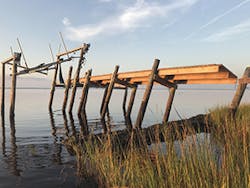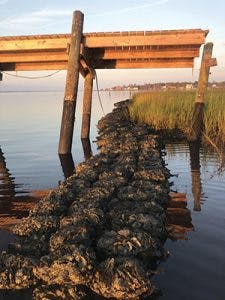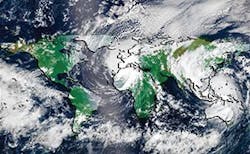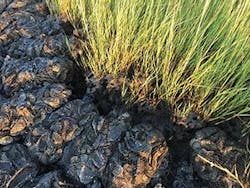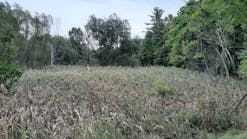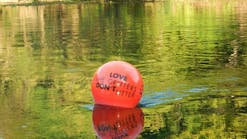Causes and remedies for coastal erosion
Carbon dioxide's impact on coastal erosion
Carbon doesn’t exactly make the world go round, but it is what makes it all hum. For billions of years, carbon-hydrogen bonds have captured, stored, and transferred the energy radiated by the sun to be used as the basis for biological life. However, exposed to flame or intense heat, in the presence of oxygen the molecular bonds tying hydrogen and carbon together can be snapped apart, releasing a spark of energy that in massive quantities has been used to fuel society. In the process, water is formed and carbon dioxide gas is generated.
It is the same carbon dioxide that makes up a minuscule proportion of the earth’s atmosphere. Invisible to the eye, yet in sufficient concentrations deadly to animal life if not quickly and efficiently expelled, carbon dioxide is, nonetheless, the ultimate boon to plant life.
In its gaseous phase, carbon dioxide is transparent to visible light, allowing the wide spectrum that we can see to pass through, while at the same time it performs somewhat like a two-way mirror when it comes to the infrared wavelengths that we perceive as heat. Carbon dioxide lets light into the atmosphere, warming the Earth’s surface, but then blocks that warmth in the form of infrared radiation, preventing it from escaping into outer space. The warmth trapped behind the “mirror” then builds up and circulates, raising temperatures to begin melting glaciers, pumping energy into storm systems, accelerating evaporation to increase water vapor content of air, and causing a range of other effects related to increased energy in the atmosphere. It doesn’t take much carbon dioxide at all to make a big difference in how much heat is trapped.
Small upticks in carbon dioxide have a disproportionate influence on the opacity of Earth’s atmosphere to infrared radiation. Think of a cup of coffee and how just a few drops of cream change the beverage from a dark, rich-but-clear character to an opaque tan. While coffee is tastier with a bit of cream—and, some would argue, sugar—added, Earth’s atmosphere is not improved when made more opaque to infrared by the addition of CO2. Although an extra dollop of cream can have the effect of cooling down a cup of java, adding extra CO2 to the atmosphere causes it to collect heat, turning Earth’s atmosphere into a long-term energy storage system.
According to Climate Central, a not-for-profit organization dedicated to communicating the science and effects of climate change to the public and decision-makers, “If we burn enough fossil fuels to heat the planet by 4°C—continuing a path of unchecked pollution—we could drown coastal cities worldwide. If we make a rapid transition to a global clean energy economy and achieve the main goal of the Paris Agreement, limiting warming to 2°C, some cities will be saved. If we go faster and further to achieve the most ambitious Paris goal, 1.5°C, the outlook improves dramatically.” The organization explains further, “Sea levels don’t respond instantly to warming, just as an ice cube doesn’t melt instantly when you take it out of the freezer. But it does melt, and they will respond. Once carbon pollution enters the atmosphere, the genie is out of the bottle. It continues heating the planet for thousands of years.” Climate Central notes recent research suggests that without cutting carbon pollution, “we could see more than 6 feet (2 meters) this century,” and even if we do reduce carbon emissions, “since we have already warmed the planet more than 1°C, many feet of sea level rise are already in the pipeline beyond what we see today.”
In the span of a couple of hundred years, industrial societies have applied flame to incalculable quantities of carbon-hydrogen bonds. If consumption of carbon-based fuel continues and carbon emissions increase, by the year 2250 atmospheric carbon dioxide concentrations could reach 2,000 ppm, a level not seen since the time of the dinosaurs 200 million years ago.
If we can imagine how different the face of the world must have been then, we can perhaps imagine how different the face of the planet will be as we approach those levels. However, we need not rely solely on our imagination to envision the effects of between 2 and 4° of excess trapped heat; a tool from Climate Central gives a visual depiction in 3D animated flyover imagery of the projected impacts of the expected rise in sea level on numerous major cities worldwide, including New York, Washington DC, London, and Tokyo: http://sealevel.climatecentral.org/maps/google-earth-video-global-cities-at-risk-from-sea-level-rise#newyorkcity.
While the Climate Central’s Surging Seas visualizations illustrate the extent of inundation that scientists project will occur anywhere from the coming decades to hundreds of years in the future, they don’t depict the devastation that occurs in the chaotic interaction between water and the built human environment in coastal regions. Long before cities find themselves submerged, erosion will likely carry away miles of coastal waterfront, wash away innumerable inland bay homesites on the coastal estuaries and river systems, and wreak havoc on coastal zone farms, towns, and villages around the world.
Increasing land loss to erosion has already occurred and is expected to accelerate as heat expansion and melting glaciers combine to push water levels upward.
Strength through science
“In Maryland, a big issue is land loss because of sea level rise and coastal erosion. It's not just an issue of higher tides but also storm events,” says Kate McClure, one of the 13 extension agents working with the Maryland Sea Grant College to provide science-based advice to communities near the coast.
“The interaction between sea level rise and storm events is a big concern for communities living near the coastline in Maryland,” she says. “Sea level rise and storm events are related to each other because, when sea levels are higher, that can mean things like storm surges and damage from storms can be even worse.” Storms, she notes, “really do shape coastline.” McClure sees her role as “helping communities use science to make decisions about the issues they care about.”
She tries to connect to communities with several key resources to obtain the information they need, including University of Maryland Sea Grant researchers. “There are researchers who are working on modeling related to sea level rise and storm surge and thinking about how those things are impacting transportation systems,” as well as other aspects of coastal infrastructure, she says.
The Maryland Climate Change Commission Science and Technical Work Group has published sea level rise projections compiled specifically for Maryland. The National Oceanic and Atmospheric Administration can also provide valuable information that can be used by local decision makers, “although a lot of their input would be from a global or national perspective,” she says. In addition, she notes that as an extension agency, Maryland Sea Grant College can help when new studies need to be done. “The role of the extension agent would be to help connect them with grants or resources for getting those done.”
She adds, “A big issue for coastal communities, especially in rural areas, is that they might have one county employee that is responsible for a lot of different things. That person doesn’t necessarily have time to keep up with all the scientific literature and be reading everything that’s coming out that could potentially be relevant to climate change and sea level rise. This is something I’ve been thinking about a lot—how to most effectively connect people in those positions with new scientific information.”
Anatomy of a changing coastal zone
As sea levels rise, marshes are going to become submerged, notes McClure. “In a totally natural system, without infrastructure built by humans, the marsh would naturally migrate inland, so places that used to be too dry for the marsh would now become tidal wetlands. But when you have cities and towns and infrastructure in place there, it can really limit the ability of those marshes to move inland.” She believes the loss of those habitats “is a pretty big deal ecologically, because they provide a lot of ecosystem services, and they are important for nursery habitats for a lot of different species that are commercially important.”
According to McClure, once a marsh is permanently inundated, it becomes open water, “and then the question becomes what is the boundary between the water and the land going to look like?” In Maryland, she says, there is a big emphasis on using living shorelines for erosion control to forestall that drastic sudden change in habitat. “The idea is, instead of building a seawall or hardened cement structure, to instead try to use more nature-based strategies—using things like native plants or rocks that can make a more natural shoreline.”
According to the Maryland Department of Natural Resources, which supports the implementation of living shorelines, a living shoreline project generally costs between $200 and $400 per linear foot, depending on factors such as site conditions and existing problems. In fact, living shoreline projects are considered as an adaptation tool by Maryland’s Climate Change Commission, and there are a number of programs based in the state that will help in financing their implementation. These include Maryland Department of Natural Resources Shoreline Conservation Service Loans, Maryland Department of the Environment loans dispersed from the Water Quality Revolving Loan Fund, and Chesapeake Bay Trust Fund grants.
Damage in North Carolina after Hurricane Florence
Standing Up To Florence
Thanks to their permeability, says Lexia Weaver, living shorelines are able to protect the shore even in cases of severe storms. Weaver is a coastal scientist and manager for the Central Regional Office of the North Carolina Coastal Federation.
Hurricane Florence had a major effect on eroding shorelines in coastal North Carolina, says Weaver. In the face of the storm, “Our living shoreline projects completely held in place. We’re using more natural approaches to control erosion as opposed to a bulkhead or a seawall. Living shorelines incorporate natural elements such as oysters, oyster shells, and plants into the shoreline stabilization method so that you’re protecting shorelines against erosion while at the same time you’re also helping to protect the environment.”
She notes, “Going around and looking at our shoreline sites, we found that the bulkheads and seawalls didn’t fare well after Hurricane Florence. There was a lot of scouring landward of the structures due to the overwash and the surge, whereas the living shorelines were completely untouched and protected shorelines from erosion.” The same was true with natural marshes, she says. “There were some areas that were eroded, but for the most part they did really well.”
Although she concedes that there were some bulkheads that did survive, she says overall, “a large majority of them got hit really hard.” Now with rebuilding going on, “We’re encouraging owners not to rebuild with bulkheads, but to rebuild with living shorelines.”
“We got a lot of calls from homeowners, both before and after the storm, about what to do to protect their eroding shorelines. A lot of people are faced with this decision. Primarily, the factors they tend to consider are cost, but also what their neighbors are doing; that has a large impact on what people do. They’ll do what their neighbor does. So if their neighbor rebuilds their bulkhead, they are likely to rebuild their bulkhead. But you get some who do their research and they want to do something natural. They recognize the importance of the estuary and the fishing and the water quality, and they want to do something more natural than the traditional bulkheads.”
Breaking Norms
She explains that bulkheads have been the norm for many years. “People liked the manicured grass growing right up to the shore, and that’s what the bulkhead gives them.” She says traditional bulkheads are what marine contractors “know how to do best.” Bulkheads also have a reputation for being simple, effective, and inexpensive, “at least at first.”
“Over the years, thousands of miles of coastal shoreline have been hardened with bulkheads to help with erosion, and it’s really only a temporary fix, because we’re seeing a lot of them having to be replaced. They may work for a few years, but over time they’re kind of a Band-Aid on the problem. It depends on where you build them. Bulkheads work better in areas of low wave energy than they do in areas of high wave energy, but when you get hurricanes all bets are off,” she says.
In contrast, living shorelines allow water to get through because of the way they are built and the material used in building them. “They are permeable. If for example they use rock, the water and the wave energy can still get through, and that wave energy is dissipated. That’s why they’ve been able to survive these wave events. When you get a big surge, it just goes over the top of them. On the other hand, with a seawall, when that wave energy comes in and hits the wall, that wave energy has nowhere to go,” she explains. “It goes back out and recedes with the wave, and over time you get scour both on top of the bulkhead and in front of it. Eventually, you lose all of your valuable salt marsh vegetation.”
She says her role in the bulkhead-versus-natural living shore debate has gradually expanded over time to include “trying to connect with marine contractors to tell them about this better method that is less expensive and is more resilient to storms.”
Thirty Feet From High Tide
Weaver says she has witnessed the erosion problem getting worse. “In the past, I’d get calls from homeowners and I’d go out. It used to be that I was able to say planting alone would help them out; just plant more grasses. But the erosion in the past few years has been more significant, to the point that in addition to the salt marsh planting, we would recommend an offshore living shoreline structure. We’ve been recommending that extra step. I feel like in the past five years the erosion has increased in central coastal North Carolina. You see a lot more of the escarpment rather than the gentle sloping shoreline.”
She adds, “We use a lot of oyster shell bags, and they have worked really well. We put them in as marsh toe revetments; we place them right up against the eroding marsh. We’ve also used granite and riprap.” The magic number for central coastal North Carolina, she says, is about 30 feet from the high tide line. “With the structure at that position offshore, it does well both environmentally and functionally.”
She says, “In higher wave areas we recommend granite. You definitely want the structure to be exposed a little bit, at least a foot at the highest water levels, but up to two feet higher in wave energy areas would be better.”
Weaver says there’s a learning curve that needs to be addressed, not just in the construction of living shorelines, but also for the permitting and administrative processes governing their implementation. “The permit process can be a little bit confusing for some homeowners, and complicated. It is for us as well,” she laughs. “So we try to help them, and we also try and find them financial assistance.” The state has an ongoing program called the Community Conservation Assistance Program through the Division of Soil and Water Conservation that provides up to $5,000 with a 75/25% cost share with the waterfront property owner for the construction of living shorelines.
Although she says the Coastal Federation has not had many cases where homeowners have dismantled bulkheads to replace them with living shorelines, there have been several cases where “living shoreline structures have been placed water-ward of existing bulkheads.” The majority of living shoreline projects in her area have been constructed in areas that have not been previously hardened.
Weaver says these living shoreline restorations are good at bringing the community together. “With the oyster shell bags, we get the community involved to assemble the bags and put them out in the water.” The more structural projects are contracted out, which she says helps the economy “by employing marine contractors and engineers to do the work. We’ve also employed fishermen to help with some of our restoration projects.”
She adds, “We’re trying to work with the agencies so that permitting is simpler for contractors. And there will soon be a temporary general permit soon,” which she believes will make the permitting process easier to navigate.
She’s doing her best to get the word out about the benefits of living shorelines from many angles. “We haven’t had trouble finding contractors to do it,” she says. She familiarizes property owners with the technique “by providing information on projects we’ve done in the past, or showing them photos of what they look like. And especially after Florence, we show them what happened to bulkheads, and we show them how the living shorelines performed, and it’s very convincing—these definitely can work. I haven’t had anyone back out. They’ve either decided not to do the bulkhead or have proceeded with the living shoreline.”
Living shoreline in North Carolina
Invasion of the Sargasso Sea
Jason Van Hoffman is a project manager for GEI Works Inc., which specializes in product lines related to liquid containment and liquid storage, erosion control, and control of waterborne contaminants. He says an emerging phenomenon affecting oceanfront property appears to be increasing in severity. Since 2011, excessive blooms of sargassum have begun plaguing the coasts of North America, South America, and the Caribbean. He explains: “One thing that we’re seeing a lot of now, because of all the nutrient-loaded runoff that’s going into the ocean, is large blooms of sargassum that at one time were very limited to particular times of the year.” Sargassum is a brown seaweed with berrylike air bladders, typically forming large floating masses. It grows prolifically in an area of the North Atlantic known as the Sargasso Sea. Scientists believe its abundance and recent increase are because of nutrient loadings from agricultural runoff making their way to the open ocean.
“What we’re seeing now is that the blooms are much larger and the timeline of when it breaks free from the Sargasso Sea and starts heading in to the shoreline has changed,” says Van Hoffman. He believes that masses of the seaweed break free earlier and are surviving longer than in the past, allowing them to wash up on shorelines, smother reefs, and disrupt ecology far beyond their normal range.
When sargassum collects on the shoreline, it starts to decay and generates corrosive byproducts. Breaking down into sulfuric oxide, the byproducts of the decay, he says, can eat through metal. “I’ve been to places where it may have been on the ground for one or two weeks, and electrical panels are completely rotted out.” Then, he adds, there’s the smell. “They’re actually evacuating small towns because of the smell. It will knock you out.”
Coastal communities are fighting back. However, according to Van Hoffman, removing the sargassum material from the shore is difficult, “requiring manpower to rake and move it via truck and take it inland for disposal in a landfill or to a storage area to dry, with the hope that the fumes don’t affect too many people.” But worse than that, he says, “As they’re removing the decaying plant material, they are also removing sand. They’re finding that they’re having to replenish 50% to 80% of their shoreline because it’s all been taken away through mechanical removal.”
In turn, removing the sand threatens the habitat of many species, including sea turtle nesting sites. Turtles are considered a protected species in many areas where the seaweed washes ashore. “There are projects going on this year, running southward from Cape Canaveral down the coast.” The sand removed along with the seaweed will need to be replenished to reestablish the affected beaches.
The damage has a different character from storm-induced erosion, explains Van Hoffman. “Storms are periodic. Let’s say a storm is going to hit Palm Beach. Yes, there’ll be significant erosion there, with the waves pounding on it and the storm surge, but that damage is kind of isolated to specific areas, whereas the sargassum hits the entire coastline.”
But he notes that it doesn’t have to be that way. He believes the better way to battle sargassum is to engage it at sea rather than on the beaches. “You want to keep it from hitting the shoreline. Sargassum is very beneficial for the environment; it’s just when it gets to the shoreline that it decomposes, it kills reefs, it sucks out all the oxygen, and promotes large fish kills.”
He says GEI has developed floating barriers that keep the sargassum from reaching the shore and “keep it flowing down the coastline.” Floating seaweed barriers, the company says, are an effective method of floating debris containment and aquatic weed and sargassum control to keep beaches clean.
GEI Works’ Orion seaweed booms can be used by beach resorts, hotels, and parks to contain, exclude, or deflect sargassum, seaweed, algae, and debris before they reach the shoreline. “Hopefully, it picks up one of the currents and heads back out to sea where it is beneficial,” he says.
He describes the system as a flotation device of fish-friendly material that hangs down depending on the depth of the treatment area of the water column. “The best solution is for the sargassum to hit the barrier and keep moving back out to sea. If that’s not a solution, and we do have to remove it, we try to funnel it to a specific location, such as a cove, so that we’re only removing it from a specific area and not the entire coastline.”
While the system is anchored strategically to meet the sargassum masses at sea, it takes some seafaring skill to get the booms in just the right position to counter the invasion. “The currents and winds are always changing,” he says. “Sometimes you have to readjust angles and direction depending on what’s going on with Mother Nature. It is kind of exciting, because not one place is the same as the other.”
